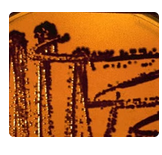The colonies seen growing on the bird seed agar appear smooth and have a distinct
reddish-brown pigmentation. The active ingredient in bird seed (Guizotia abyssinica) agar
is caffeic acid, which is extracted and placed in an agar containing 1% glucose. Of the
cryptococci, and other species of yeasts, Cryptococcus neoformans selectively produces
the enzyme phenoloxidase, which oxidizes the caffeic acid in the medium to melanin,
producing the red-brown pigmentation.
The other yeast species included in this exercise do not possess phenoloxidase activity
and therefore remain non-pigmented when grown on bird seed agar.
The colonies shown in this photograph were grown on Guizotia abyssinica (bird seed) agar
at 30°C for 72 hours. The most likely identification is:
A. Cryptococcus laurentii
B. Cryptococcus neoformans
C. Candida parapsilosis
D. Saccharomyces cerevisiae
The steps in the PCR process are:
1. Denaturation (Turning double stranded DNA into single strands.)
2. Annealing/Hybrization (Attachment of primers to the single DNA strands.)
3. Extension (Creating the complementary strand to produce new double stranded DNA.)
What is the first step of the PCR reaction?
A. Hybridization
B. Extension
C. Annealing
D. Denaturation
Match each of the following definitions associated with heart disease and heart failure to
the term that it defines.
1. Congestive heart failure
2. Infarction
3. Ischemia
4. Angina
A. An inadequate blood supply that decreases availability of oxygen.
B. Chest pain caused by inadequate supply of oxygen to heart myocardium.
C. An area of tissue death that occurs due to lack of oxygen.
D. A left ventricular dysfunction resulting from aging, hypertension, atherosclerosis or muscle damage from an AMI or repeated AMIs.
The dematiaceous molds can be broadly separated into two major groups: the agents of
chromomycosis that grow more slowly, maturing only after 7 days or more of incubation,
and the more rapidly growing species that most commonly are clinically insignificant
commensals or contaminants when recovered from clinical specimens, but in rare
situations may cause opportunistic infections called phaeohyphomycosis.
Dematiaceous molds can be broadly separated into two major groups; the agents of
chromomycosis and clinically insignificant commensals or contaminants. The agents of
chromomycosis grow: more slowly than; more rapidly than; or generally at the same rate as
the clinically insignificant commensals or contaminants?
A. more slowly than
B. more rapidly than
C. generally at the same rate as
The recommended order of draw for a complete blood count (CBC), prothrombin time, and cholesterol is:
A. light blue, red, and lavender
B. light blue, lavender, and red
C. red, lavender, and light blue
D. lavender, light blue, and red
Blood plasma will contain coagulation proteins, but not in a clotted tube where serum is present. Blood serum contains each of the following substances except:
A. Water
B. Sugars
C. Coagulation proteins
D. Electrolytes
1. A
2. A
3. B
4. A
5. B
6. B
A cardiovascular risk marker is an analyte in a body fluid that can be measured by the
clinical laboratory and has been associated with the development of cardiovascular
disease. Examples of risk markers include: LDL-C, triglycerides, and hs-CRP.
A cardiovascular risk factor is a condition (not a laboratory analyte) that is associated with
an increased risk of developing cardiovascular disease. Examples of risk factors include:
smoking, obesity, diabetes and hypertension.
Determine if each of the following is a cardiovascular risk marker or a cardiovascular risk
factor.
1. Smoking
2. Obesity
3. Low density lipoprotein (LDL)
4. Hypertension
5. Triglycerides
6. High sensitivity-C-reactive protein (hsCRP)
A. Cardiovascular risk factor
B. Cardiovascular risk marker
Small, dense LDL is most likely to interact with arterial walls, leading to deposition of
cholesterol, and initiating or worsening atherosclerosis. Small, dense LDL is associated
with more than a three-fold increase in the risk of coronary heart disease.
Large, buoyant LDL is less atherogenic than small, dense LDL.
The LDL phenotype A is normal. It is the so called 'B' pattern that is associated with
increased risk.
Which of the following is most likely to interact with arterial walls, leading to deposition of
cholesterol, and initiating or worsening atherosclerosis?
A. Large buoyant LDL
B. Small dense LDL
C. LDL phenotype 'A'
Thyroid-stimulating immunoglobulins, or TSI's, are IgG antibodies that can bind to thyrotropin (TSH) receptors on the thyroid gland. TSIs mimic the action of TSH, causing excess secretion of thyroxine and triiodothyronine. The TSI level is abnormally high in persons with hyperthyroidism due to Graves' disease. Which of the following is an autoantibody that binds to TSH receptor sites on thyroid cell membranes preventing thyroid-stimulating hormone binding?
A. Antithyroglobulin
B. Antimicrosomal antibodies
C. Thyroid-stimulating immunoglobulins
D. Thyroxin-binding globulins
E. Lupus erythematosus
Only non-self antigens can be immunogenic. Self antigens are normally recognized by the immune system as part of the host, so an immune response does not normally occur. Nonself antigens are immunogenic since they have the potential to cause an immune response. For a substance to be immunogenic it must be:
A. A linear molecule
B. A lipid
C. Less than 5,000 molecular weight
D. Recognized as non-self
E. A haptene
A patient with tuberculosis would be placed in:
A. protective isolation.
B. body fluid isolation.
C. droplet isolation.
D. airborne isolation
A casual blood glucose >/= 200 mg/dL on a patient with symptoms and an A1C >/= 6.5%
meet diagnostic criteria for diabetes.
Chemistry
A physician is evaluating a 45-year-old obese male for diabetes and orders a plasma
glucose at time of evaluation and a HbA1C one week later. The patient has a family history
of diabetes and currently exhibits symptoms of diabetes.
What would be the best course of action if these are the blood glucose results?
Casual Blood Glucose: 208 mg/dL
HbA1C one week later: 7.2%
A. Order insulin levels; if decreased, diagnose diabetes
B. Patient meets criteria for diagnosis of diabetes
C. Order a C-peptide for diagnosis
D. The patient is at risk for diabetes (pre-diabetic); monitor for diabetes with yearly FPG levels
| Page 12 out of 47 Pages |
| Previous |